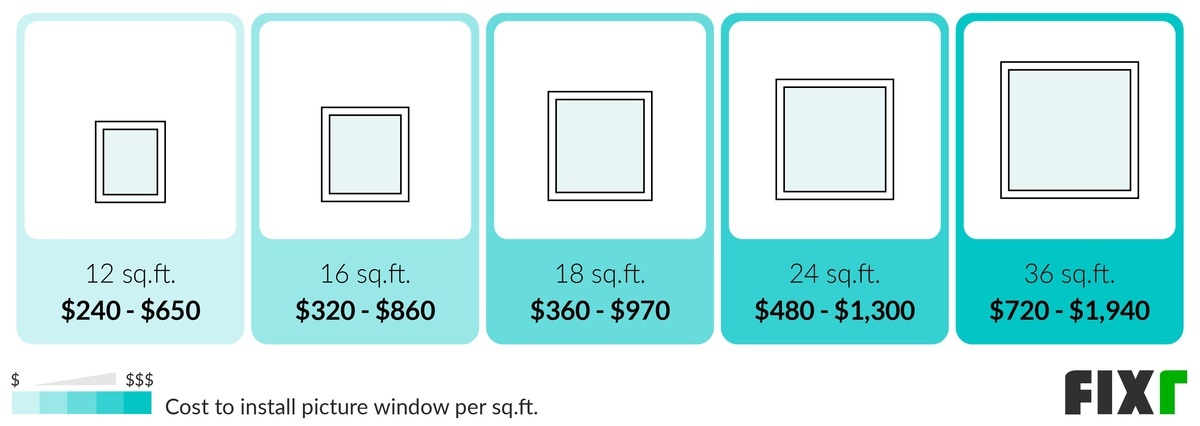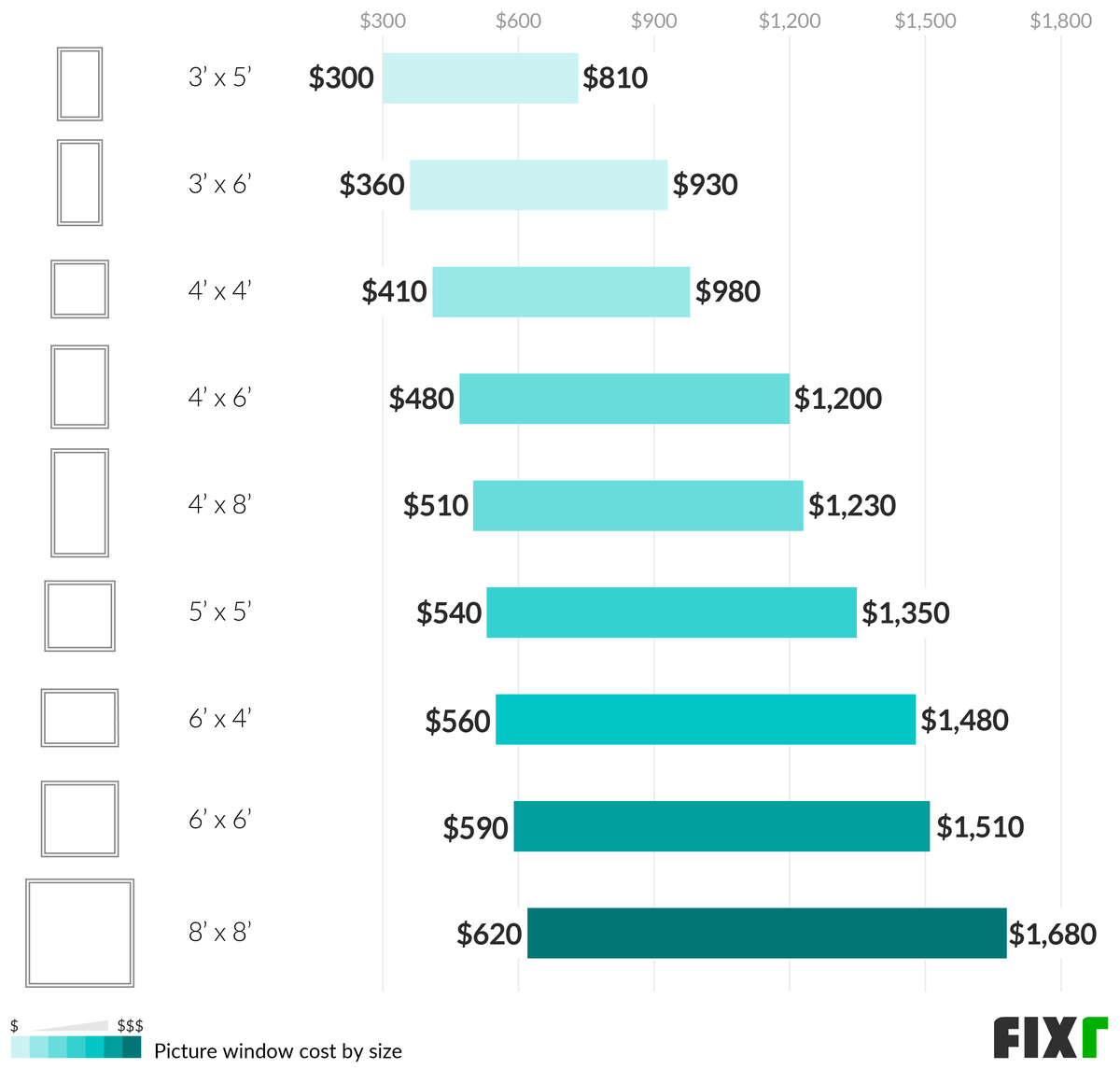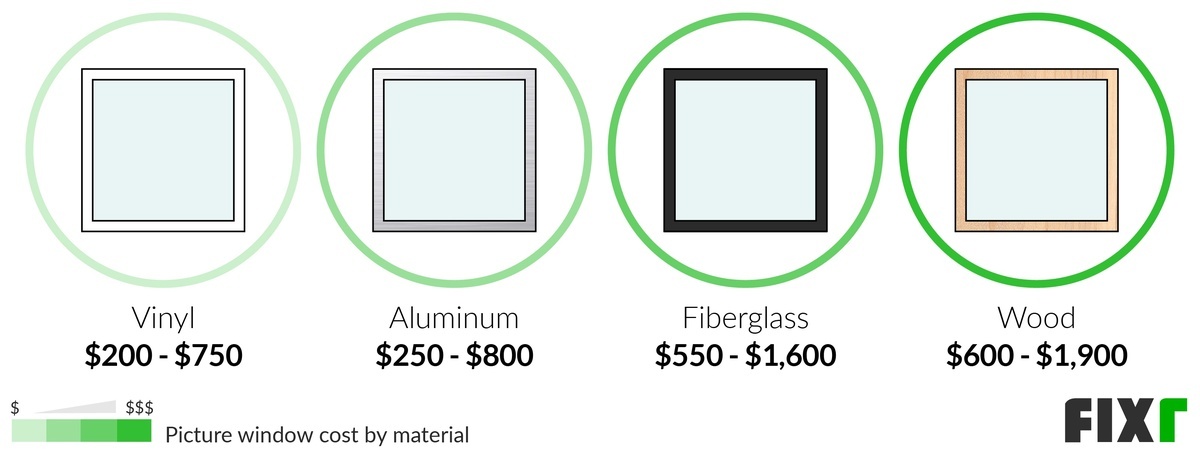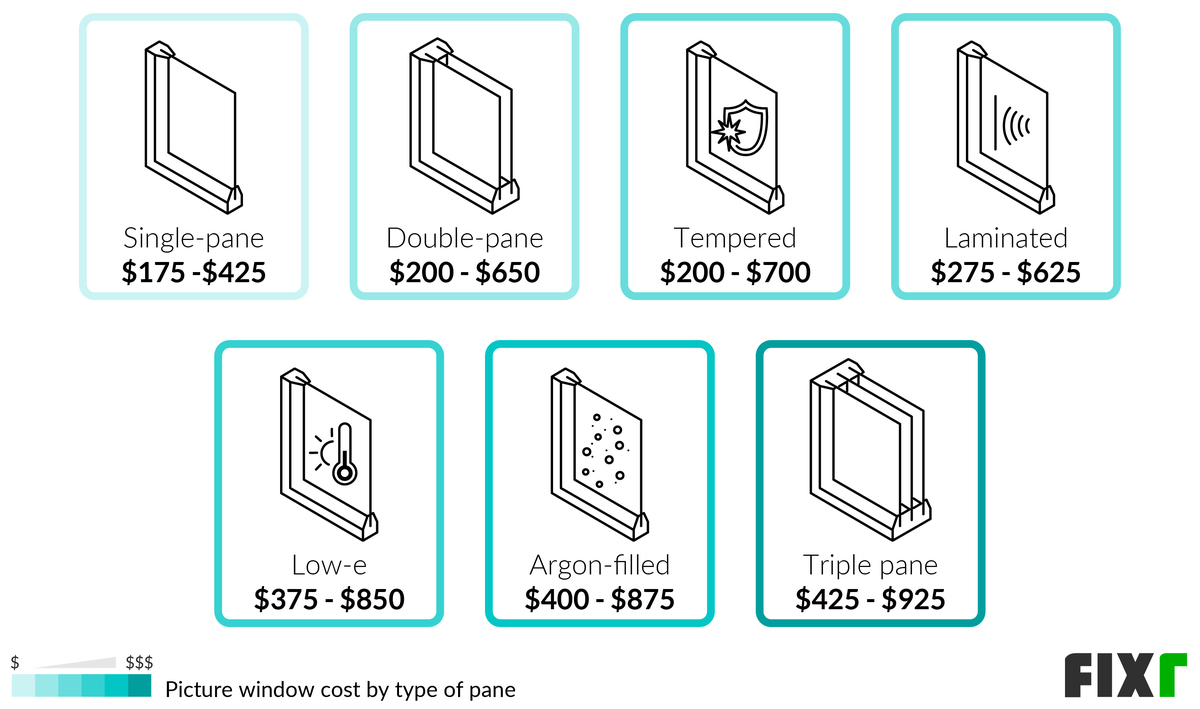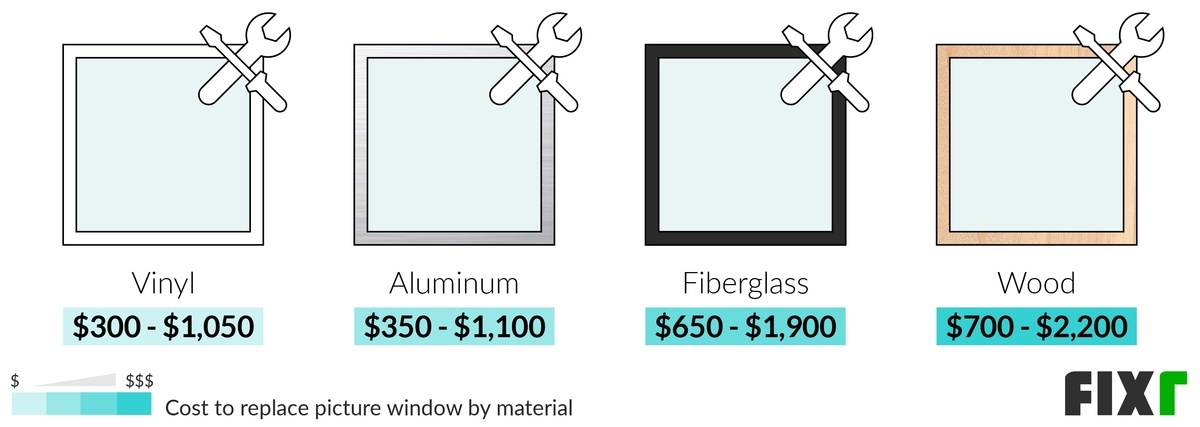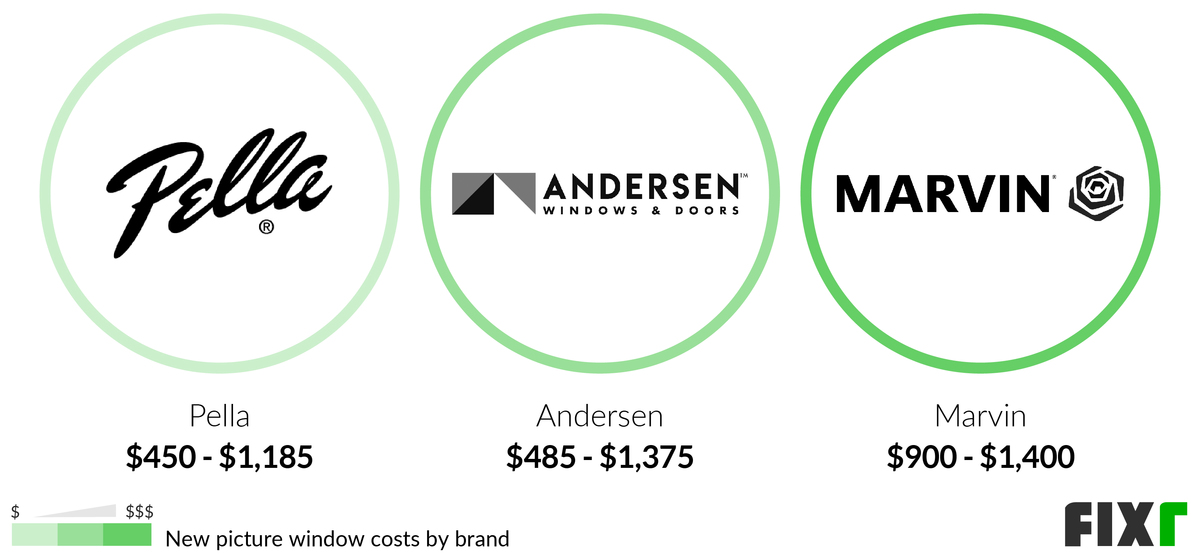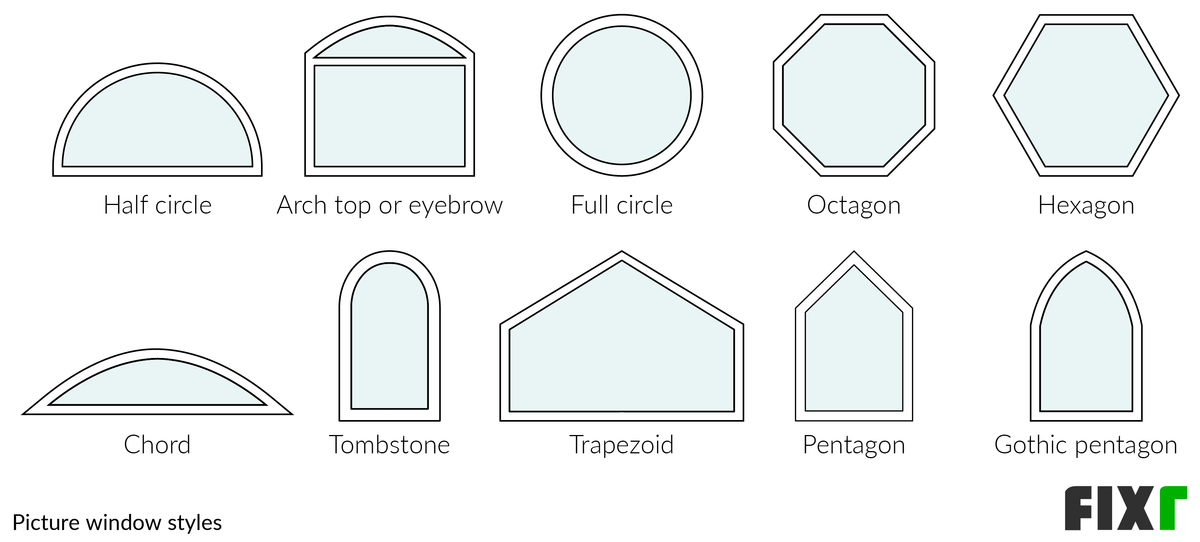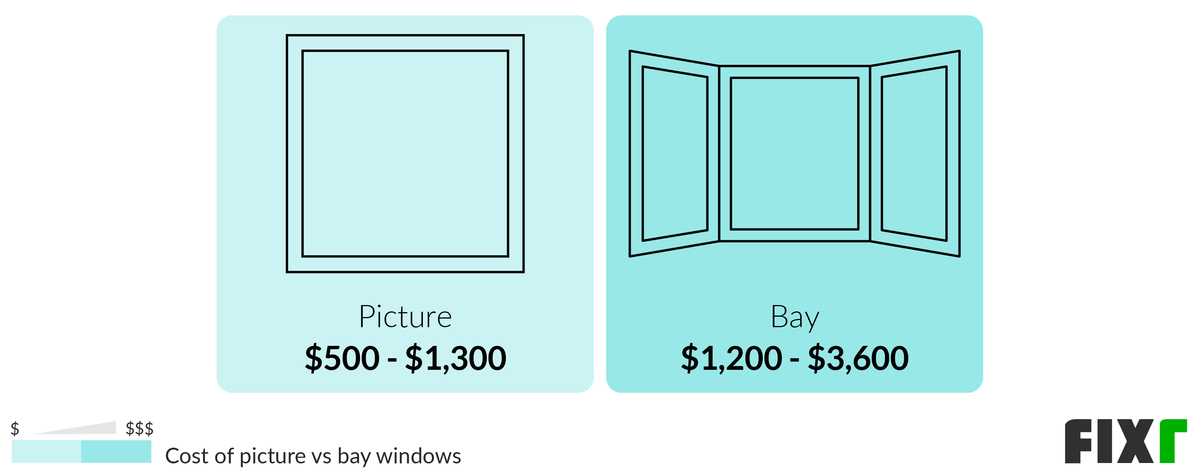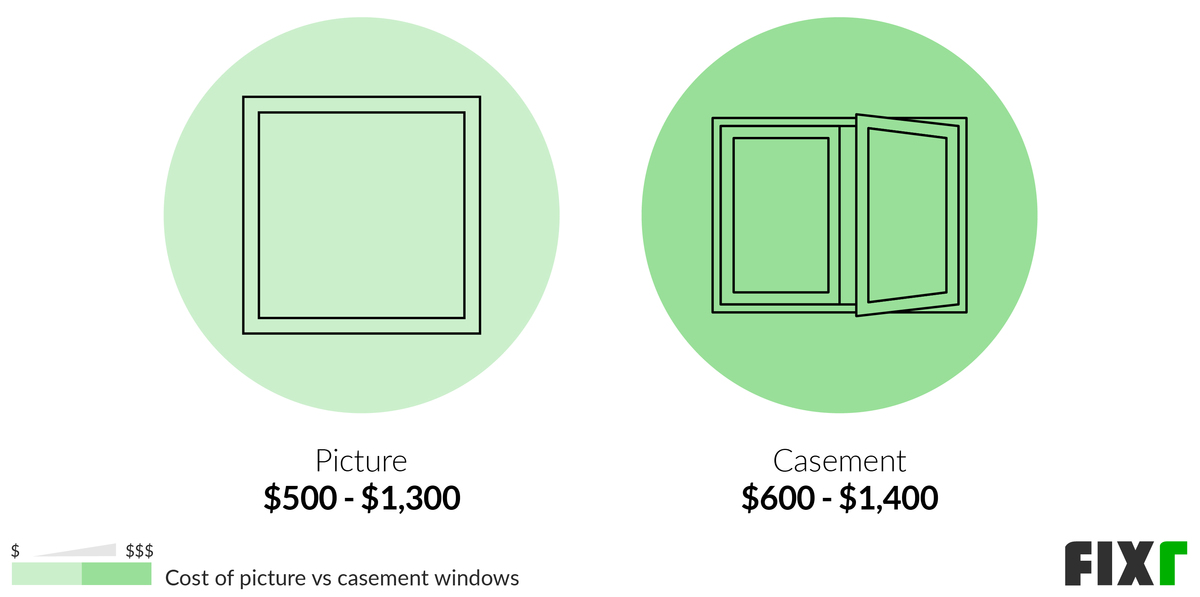How Much Does It Cost to Install Picture Windows?
Picture windows are popular with homeowners as they provide an unobstructed view of the outdoors, free from additional wood and separations. This kind of windows give you the best light in a room and create a more open concept in your home design.
Choosing the perfect picture window for your home includes deciding on the best type of glass, appropriate frame style, and size area you want the window to be placed. These factors affect the cost, but the national average range for installing picture windows is between $500 and $1,300. Most homeowners pay around $700 for a 6 foot x 4 foot window with double pane glass and an aluminum frame. Costs for this type of window run as low as $350 for a 3 foot x 4 foot vinyl picture window with single pane glass, standard frame, for a small opening. Prices can reach as high as $2,000 for a custom 8 foot x 4 foot wood-framed window with triple-pane, Argon gas-filled glass.
Picture Window Cost
| Cost to Install Picture Window | |
|---|---|
| National average cost | $700 |
| Average range | $500-$1,300 |
| Low-end | $350 |
| High-end | $2,000 |
In this guide
Picture Window Cost by Size
Picture Window Cost by Material
Picture Windows Price by Type of Pane
Picture Window Installation Cost
Picture Window Replacement Cost
Cost to Replace Large Picture Window
New Picture Window Cost by Location
New Picture Window Cost by Brand
Picture Window Styles
Custom Picture Windows
Energy-Efficient Picture Windows
Maintenance
Pros and Cons
Bay Window vs Picture Window
Casement vs Picture Window
Enhancement and Improvement Costs
Additional Considerations
FAQs
Picture Window Installation Cost by Project Range
Picture Window Cost per Square Foot
One of the biggest factors that affects the cost you pay for your picture window is the square footage. Homeowners pay between $20 and $54 per square foot, depending on the materials used for the project. While you can have the size of your window customized to fit any size space, some sizes are more common. Below you will see some of the most common square footage and the average cost range you can expect for each.
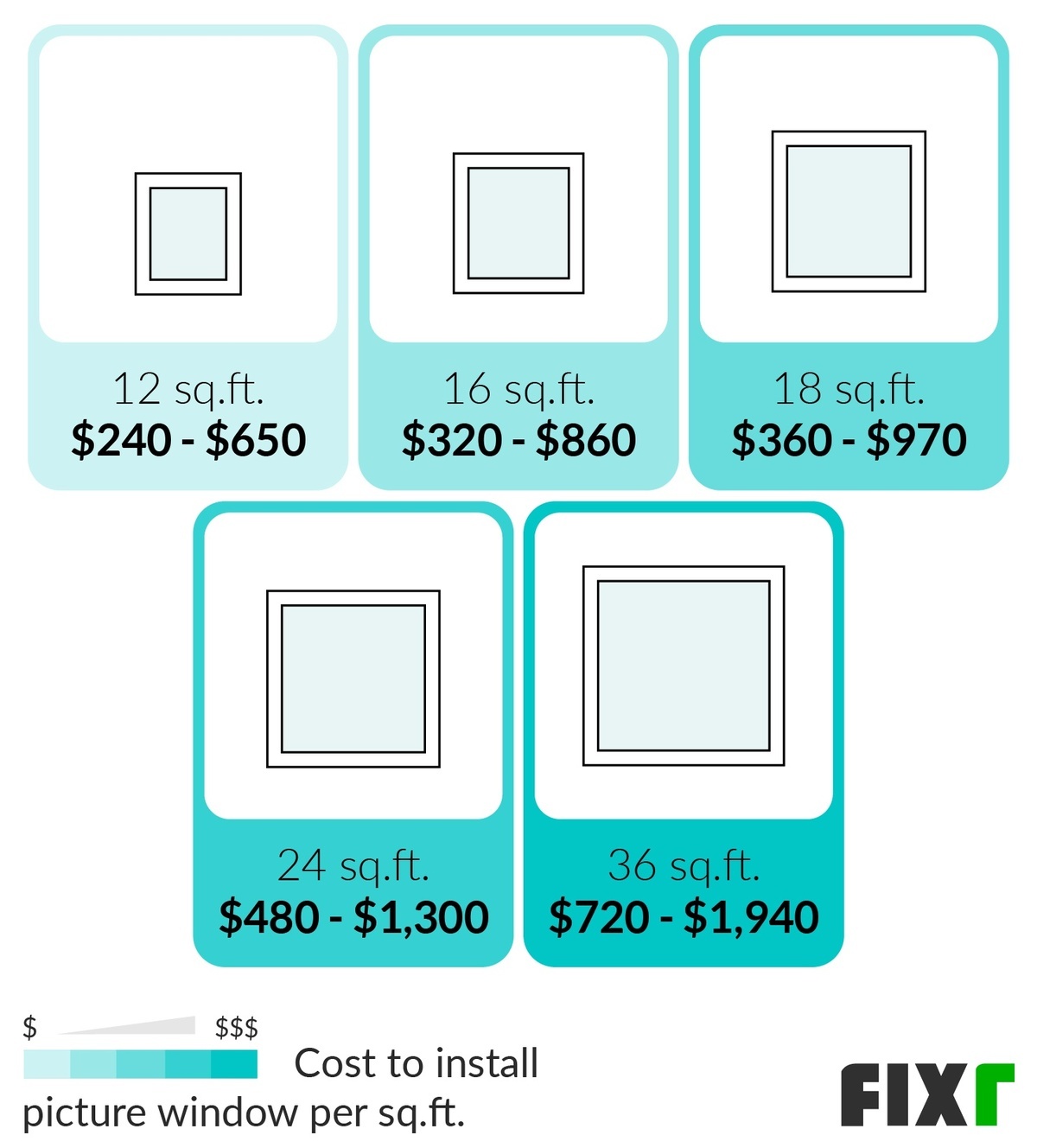
| Square Footage | Average Cost (Installed) |
|---|---|
| 12 sq.ft. | $240 - $650 |
| 16 sq.ft. | $320 - $860 |
| 18 sq.ft. | $360 - $970 |
| 24 sq.ft. | $480 - $1300 |
| 36 sq.ft. | $720 - $1,940 |
Picture Window Cost by Size
Picture windows come in a range of heights that range from one to eight feet, with widths that most often come in standard sizes such as 2, 3, 4, 6, and 8 feet. While the smaller widths, such as three feet, start around $300 to $350, larger widths such as six feet start upwards of $500. The reason for this is that even though the height varies, the wider widths require a larger frame, and the installer will be working with a more cumbersome piece of glass. Below you will see some of the most common sizes and the average cost you can expect to pay for each.
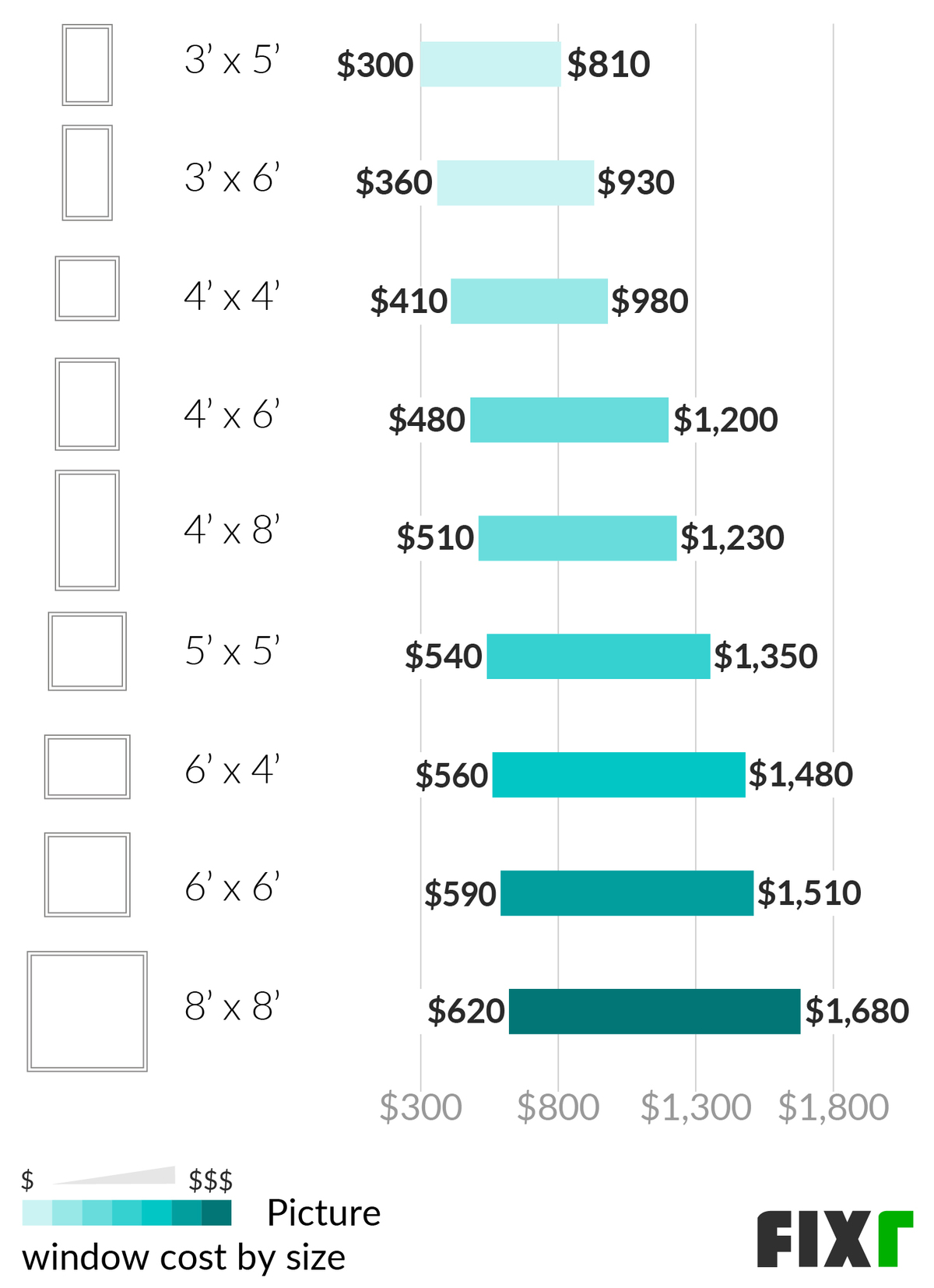
| Size | Average Costs (Installed) |
|---|---|
| 3' x 5' | $300 - $810 |
| 3’ x 6’ | $360 - $930 |
| 4’ x 4’ | $410 - $980 |
| 4’ x 6’ | $480 - $1,200 |
| 4’ x 8’ | $510 - $1,230 |
| 5’ x 5’ | $540 - $1,350 |
| 6’ x 4’ | $560 - $1,480 |
| 6’ x 6’ | $590 - $1,510 |
| 8’ x 8’ | $620 - $1,680 |
Picture Window Cost by Material
One of the largest expenses associated with picture window installation is the cost of the frame and glass. You pay anywhere from $200 to $1,150 for material only, depending on the frame option you select. Each frame material had its own benefits, drawbacks, and aesthetic look. Below you will see the most common frame materials and the average cost you can expect to pay for each one.
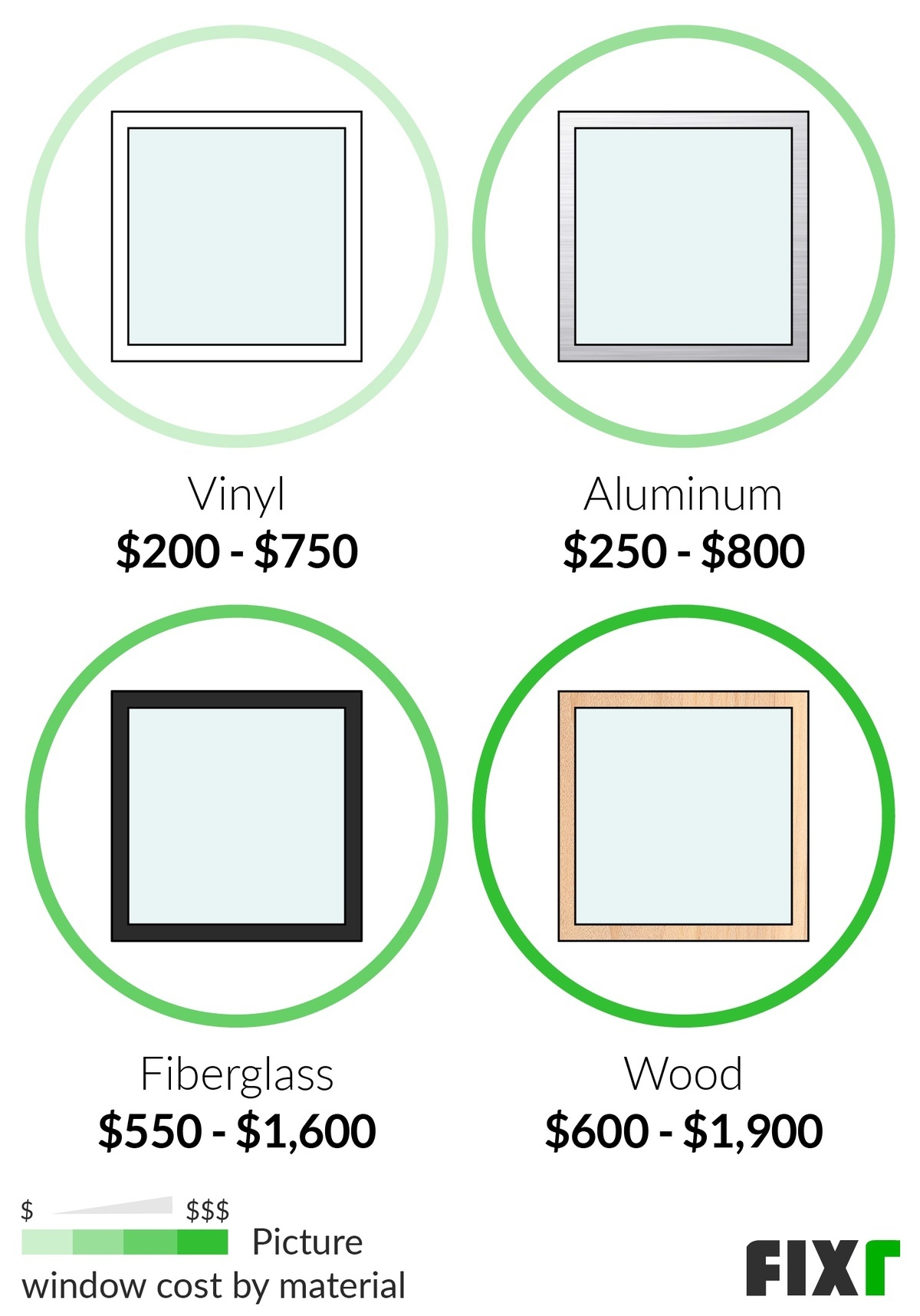
| Material | Average Costs (Materials Only) |
|---|---|
| Vinyl | $200 - $750 |
| Aluminum | $250 - $800 |
| Fiberglass | $550 - $1,600 |
| Wood | $600 - $1,900 |
Vinyl Picture Window
The material cost for a vinyl picture window runs between $200 and $750. It is often the least expensive option. While it is fairly durable, it will not often last as long as other types. Vinyl is a popular option due to its low cost and easy maintenance. They can easily be wiped clean if they become dirty, and they won’t crack or peel. The main drawback to this type for many homeowners is the fact that it is not easily paintable. To paint, you would need to sand it down first, and it still may not cover as well.
Aluminum Picture Window
Installing an aluminum picture window costs around $250 to $800 for the material. Aluminum is a popular choice for its modern look and slim profile. They are lightweight, which provides a simpler appearance. You can paint them to customize the color in your room. They don’t crack or peel with wear. The primary con of this type of frame is that it may stick when it expands.
Fiberglass
Fiberglass picture window material costs between $550 and $1,600. Fiberglass frames also have a slim profile and are popular options for homeowners looking for a type that is long-lasting and durable. Fiberglass-framed windows will not bend or warp. They will not crack or peel. They are also paintable and energy-efficient. The only drawback to this option is the cost.
Wood Picture Window
Wood frame picture windows are the most expensive type, running between $600 and $1,900. While they are one of the costliest options, they are aesthetically pleasing and available in several thicknesses and styles. They are paintable, long-lasting, and provide good installation. The main drawback besides the cost is that this type of frame can stick when it expands.
Picture Windows Price by Type of Pane
Aside from the frame, the other main factor involved in the cost is the type of pane you choose. Panes come in a range of prices that are most often related to their level of efficiency. Basic panes will be less expensive but will not block out the sun’s rays or heat as much. Others have special construction or a coating to maximize their energy efficiency. Below are the costs for material for the most common type of pane options.
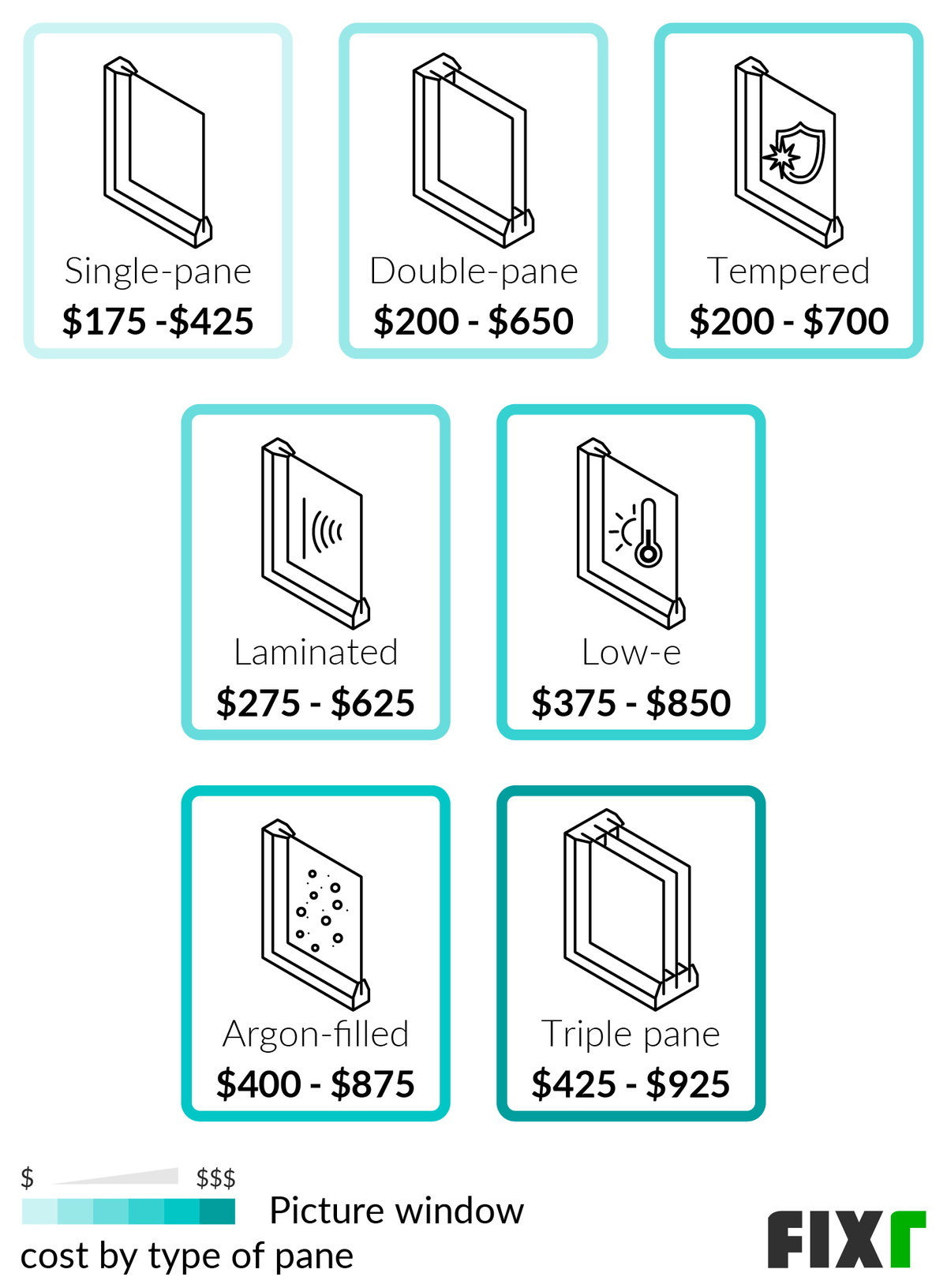
| Type of Pane | Average Costs (Materials Only) |
|---|---|
| Single Pane | $175 - $425 |
| Double Pane | $200 - $650 |
| Tempered Glass | $200 - $700 |
| Laminated Glass | $275 - $625 |
| Low-E | $375 - $850 |
| Argon-Filled | $400 - $875 |
| Triple Pane | $425 - $925 |
Single Pane Picture Window
The glass for a single pane window runs between $175 and $425 and is considered one of the most basic window types. The window is one layer of glass with one glazing. They tend to be found more often in older homes because they do not offer the quality of insulation or noise reduction available with other types of glass. Yet, their low cost makes them appealing to some homeowners.
Double Pane Picture Window
You can expect to pay between $200 and $650 for the glass on a double pane window. Double pane windows have two layers of glazing or glass and are often referred to as insulated glass. Double panes have become the standard because the two pane designs with the middle air pocket create better insulation. They are a great option for those looking for better efficiency at a lower cost.
Tempered Glass
Tempered glass is in the more moderate ranges of window glass and runs between $200 and $700. Tempered glass is a form of safety glass created by putting glass through a process involving heat and pressure. Once tempered, the glass can still shatter, but it is much less likely to break when compared to regular glass. If it breaks, it is less likely to result in cuts.
Laminated Glass
You can expect to pay between $275 and $625 for laminated glass. Laminated glass is created when resin is bonded to two layers of glass to make it five times stronger than traditional glass. It is designed to reduce the risk of breach from forced entry, rocks, and even bullets. It is known for its ability to reduce noise and block UV rays.
Low-E Glass
Low-E glass is designed to reduce the amount of sunlight and UV light entering the home. The glass alone runs between $375 and $850. Low-E stands for low emissivity, which translates to a lower amount of energy radiated by the glass. The glass is coated with a layer of metallic oxide, reducing energy loss between 30% and 50%.
Argon-Filled Glass
Argon-filled glass runs between $400 and $875 for the glass alone and is one of the more expensive window options. Argon-filled windows are most often double-paned but can be triple-paned with argon glass filled in the ¼-inch space between the panes. This glass provides significantly better insulation for wider windows than any other option.
Triple Pane Picture Windows
You can expect to pay anywhere between $425 and $925 for triple pane picture window glass, making it one of the most expensive options. Triple-pane glass is created by using three pieces of glass or glazing layers. In some cases, it is referred to as thermopane glass. This is by far the most energy-efficient window type and is highly durable.
Picture Window Installation Cost
Picture window installation costs run anywhere between $60 and $110 per hour, depending on the company’s hourly rate. Typically, the installation requires two to four professionals, depending on the size of the window. During the installation process, your professional prepares the area, which may involve adjusting the opening. They will then place the window in, seal it, and put on the trim. Typically, the glass will be cleaned after the process is complete. You can expect the entire process to take 45 minutes to an hour and a half.
Picture Window Replacement Cost
Picture window replacement costs per hour are slightly less, running from $40 to $90. Replacing a window is often cheaper as the area is already prepped, and often the original trim will be reused, as long as it is not damaged. They follow the same process as with the new installation, except they start by removing the trim and the old window. The process takes one to two hours. It can take slightly longer than a new install because it requires additional time for the trim and original glass to be removed.
In cases where the trim can be used, you will find the total cost is lower. However, the labor is slightly higher than that of a new installation as the previous window will need to be removed, increasing the labor. Below you will see the average costs to replace each type of window, including labor.
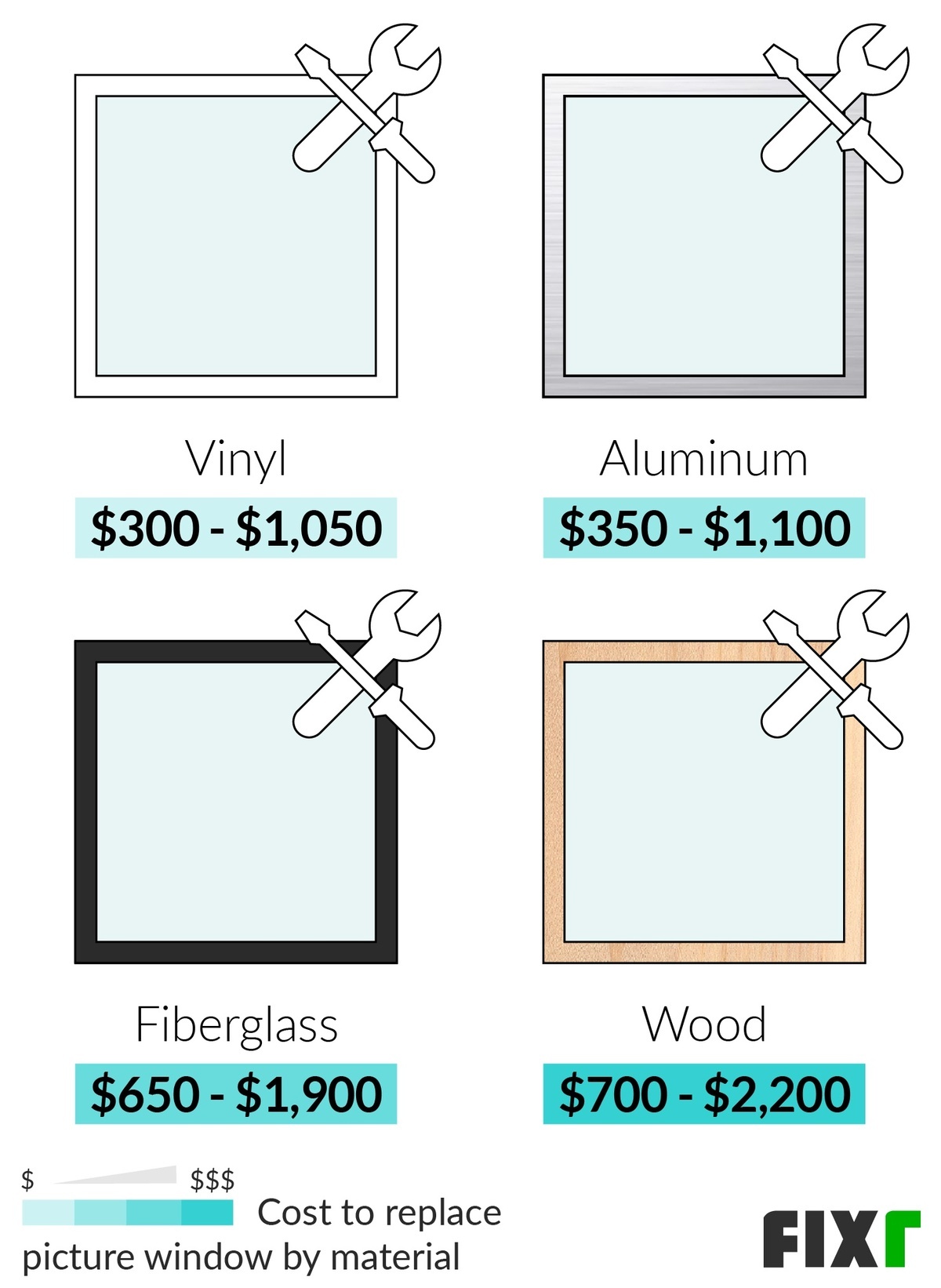
| Material | Replacement Costs (Installed) |
|---|---|
| Vinyl | $300 - $1,050 |
| Aluminum | $350 - $1,100 |
| Fiberglass | $650 - $1,900 |
| Wood | $700 - $2,200 |
Vinyl Picture Window Replacement
Vinyl windows are one of the least expensive windows, whether installing new ones or replacing existing ones. Replacement costs run from $300 to $1,050, depending on the size. As long as the vinyl frame is in good condition, your professional can reuse it during the installation process. In a new install, you must purchase the window with the vinyl frame attached, increasing the overall costs. If planning to reuse the frame, it is a good idea to make sure it is clean well before the installation process.
Aluminum Picture Window Replacement
Aluminum windows are more cost-efficient to replace with an average cost of $350 to $1,100. In many cases, the aluminum frame will be removed with the window. The replacement window will be installed in the same way a new aluminum picture window would be installed, but the area will not need to be prepped in the same way as it would with a new install as long as you are replacing it with the same size window. If the frame can be salvaged, your professional will make sure it is cleaned to prevent rusting.
Fiberglass Picture Window Replacement
If you need to replace a fiberglass picture window, you can expect the replacement cost to be $650 to $1,900. The cost for fiberglass window replacement is high because the new replacement window will need to come with the frame attached, as fiberglass frames cannot be reused. Your professional must remove the old cladding and replace it with new when putting your replacement fiberglass window into place.
Wood Picture Window Replacement
Replacing a wood picture window is the most expensive and costs $700 to $2,200. The cost of replacement depends not only on the size of the window but also on whether you reuse the old wood trim. If the trim is in good condition and you want the same style, it can likely be salvaged. In some cases, it may benefit from sanding and restaining. If it is extremely worn, damaged, or you want a new look, it will need to be replaced with the window.
Cost to Replace Large Picture Window
A small picture window takes less than an hour to replace. However, a larger one may take one to two hours because the glass and frame are heavy and require a more exact fitting. In addition to this, larger windows require up to four individuals for the installation process, putting your labor installation costs at $200 to $300 per hour. Extra individuals are often needed due to the weight of the glass. Also, larger windows typically require two people to hold it in place while another one secures it. For this reason, the labor costs of removing an old large picture window and replacing it with a new one are between $400 and $600.
New Picture Window Cost by Location
The location of your picture window affects the total costs you will pay for the project. While labor costs won’t increase with installations in different rooms, you are likely to use certain sizes in certain areas, affecting the average costs. Below you will see the most common rooms to install this type of window and the average cost you can expect to pay for your installation.
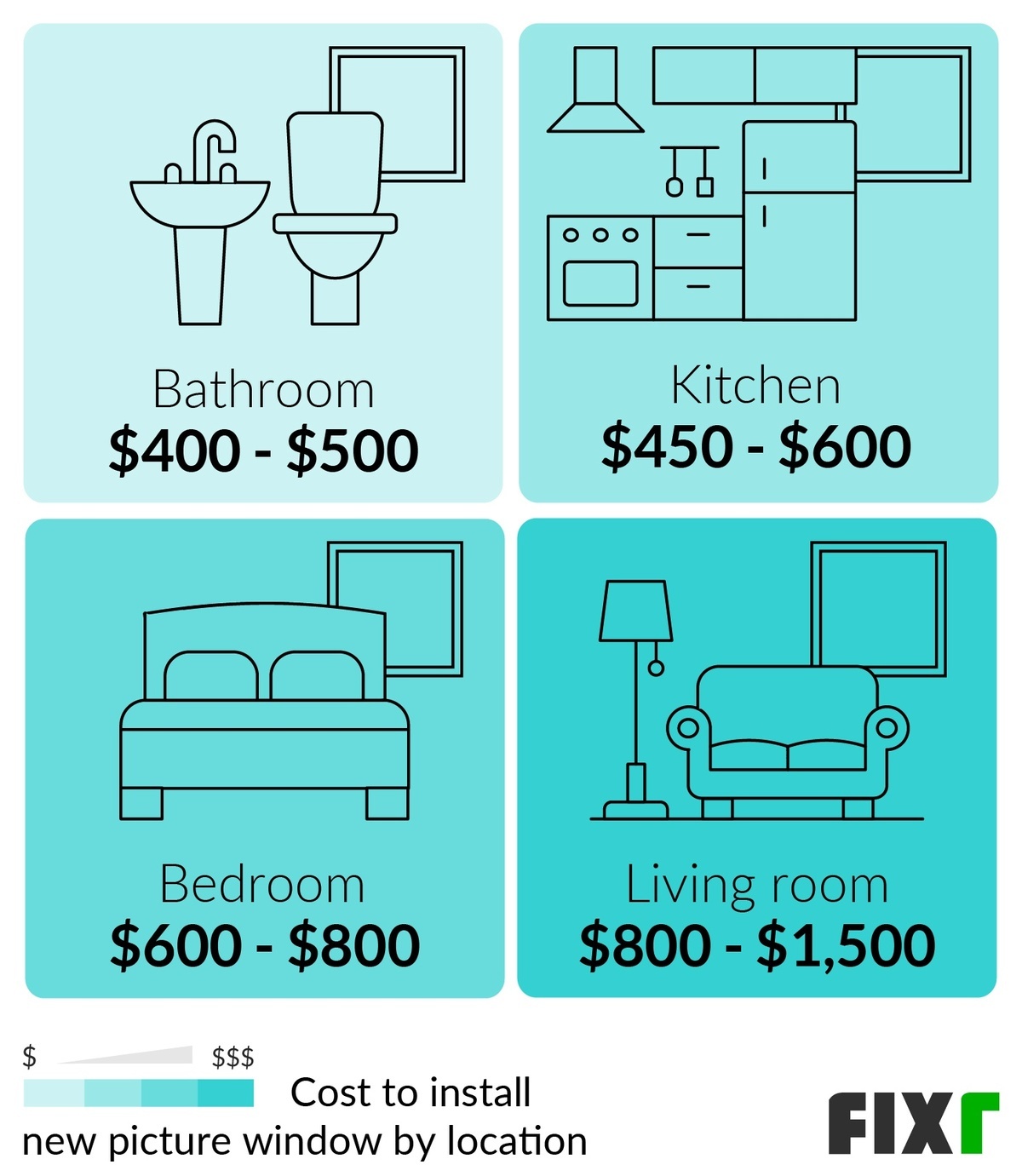
| Location | Average Costs (Installed) |
|---|---|
| Bathroom | $400 - $500 |
| Kitchen | $450 - $600 |
| Bedroom | $600 - $800 |
| Living Room | $800 - $1,500 |
Bathroom Picture Window
One of the least expensive places to install a picture window is the bathroom, with an average price of $400 to $500. Since most bathrooms are small and require privacy, picture windows will be small circle or half-circle windows placed higher up on the wall. Having one of these windows in the bathroom will let natural light in, which will make the bathroom nice and bright. Typical sizes are 2’ x 2’ or smaller.
Kitchen Picture Window
A kitchen picture window sets you back between $450 and $600. Most kitchens are central to the house and require a lot of light since they can be used any time of the day. Typically, picture windows in the kitchen are moderate sized and often rectangular or tombstone in shape. They can increase the light and add to the view, depending on where the exterior wall is located. The size of the window depends on the size of your kitchen, but the most common sizes are 2’ x 3’ or 3’ x 4’.
Picture Window in Bedroom
Bedroom picture windows cost between $600 and $800 and come in various shapes, depending on your bedroom decor. They tend to be moderate-sized to larger, with popular styles being rectangles and tombstones with or without an arched top. This type of windows are popular in homes with a beautiful outside view but can also be chosen by homeowners who enjoy a well-lit bedroom. The average sizes run from 3’ x 4’ to 4’ x 6’.
Picture Windows for Living Room
The living room is the most popular place to install a picture window and also the most expensive. You can expect to spend between $800 and $1,500, depending on the size. When installed in the living room, this kind of windows are often used to enhance a view and provide the room with a significant amount of light. Two of the most popular styles in the living room are large rectangular ones or smaller tombstones. Sizes most commonly used depend on the space but are often 4’ x 6’ or larger.
New Picture Window Cost by Brand
While size and location are important factors, the brand of window you choose will also have a significant bearing on the cost. Each brand will typically have at least a basic warranty and may vary slightly by the style and trim options. Below you will see three of the most popular picture window brands and the average cost to have a window installed.
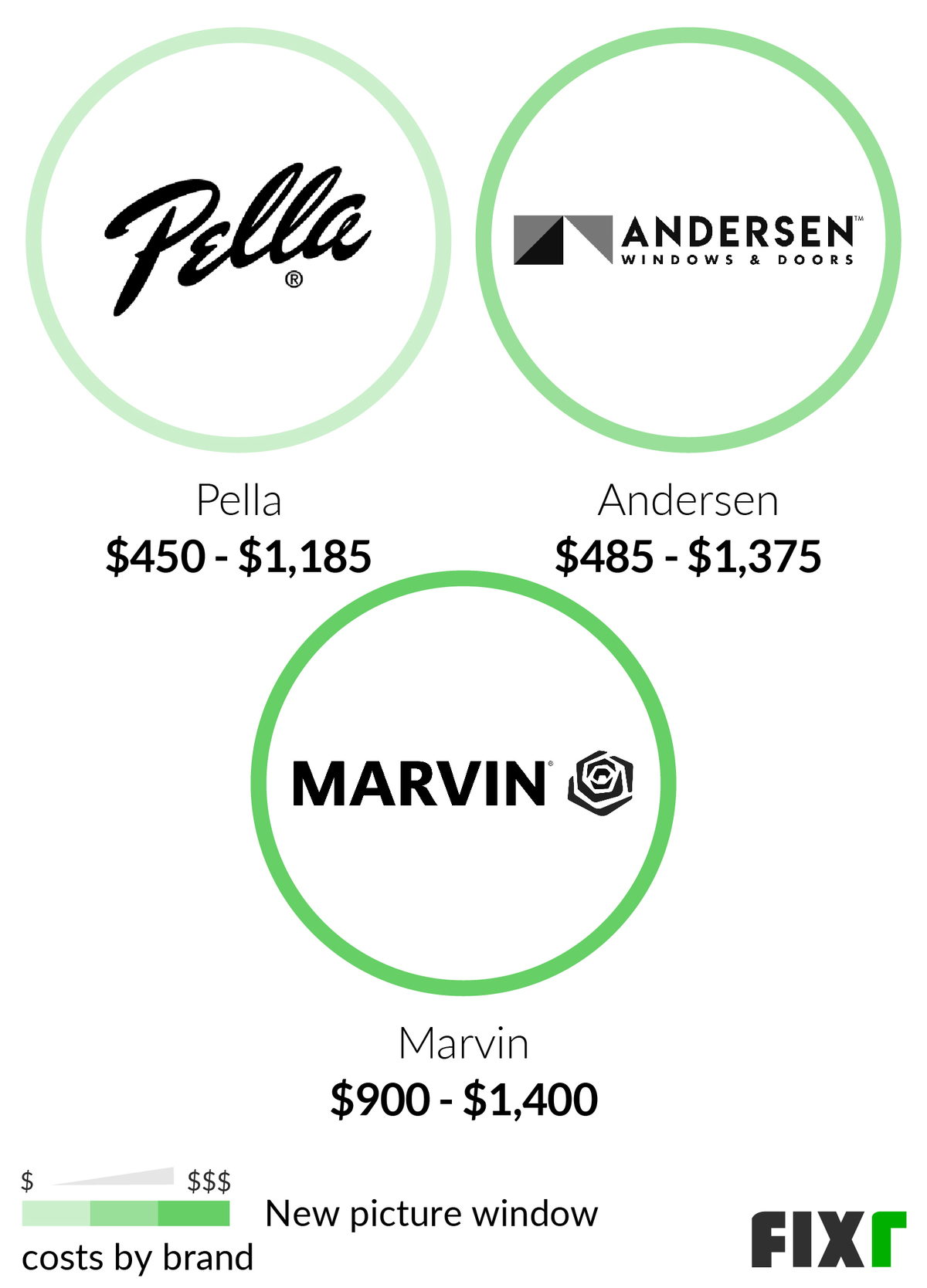
| Brand | Average Costs (Installed) |
|---|---|
| Pella | $450 - $1,185 |
| Andersen | $485 - $1,375 |
| Marvin | $900 - $1,400 |
Pella Picture Window Prices
Pella picture windows run between $450 and $1,185 installed, depending on the size and style you choose. They offer wood, fiberglass, and vinyl trims and several energy-efficient glass options. While they do not have an aluminum-only trimmed picture window, they offer an aluminum-clad wood option from their Reserve Series, which adds a unique and elegant look to any room. Pella backs their windows with a limited lifetime warranty, one of the strongest in the industry.
Andersen Picture Window Prices
The average cost of installing an Andersen picture window runs between $485 and $1,375, depending on the size and whether or not you need a custom fit. Anderson windows are known for their wide range of trim offerings and window shapes and their ability to create custom windows for any location. On top of that, they have one of the most unique warranties in the industry. Their warranty covers the window glass for up to twenty years and the non-glass items for up to ten. Yet, what makes their warranty unique is that it will transfer with the house when sold.
Marvin Picture Window Cost
One of the most expensive brands is Marvin. You can expect to pay between $900 and $1,400 for a Marvin picture window. The cost depends on the size with Marvin windows and the window series you choose. Their least expensive series is the Signature one, but hey also have the Elevate Series, which is more moderate, and the Essential Series, which is the costliest. Each series offers different exterior trim options and glass choices. Warranties from Marvin are a little different as each component will be covered under a different one. The glass has a 20-year warranty, the hardware has a 10-year warranty, and the interior cladding has a 5-year warranty.
Picture Window Styles
The cost to install a picture window depends on the type of glass chosen, the desired frame style, and the size. The shape of the window has little to do with the cost if you choose one of the standard options below. But choosing the right style is important as certain styles fit in with specific decor motifs and themes and better fit and fill the space where the window is being installed. Below you will see the common styles and when they are most commonly used.
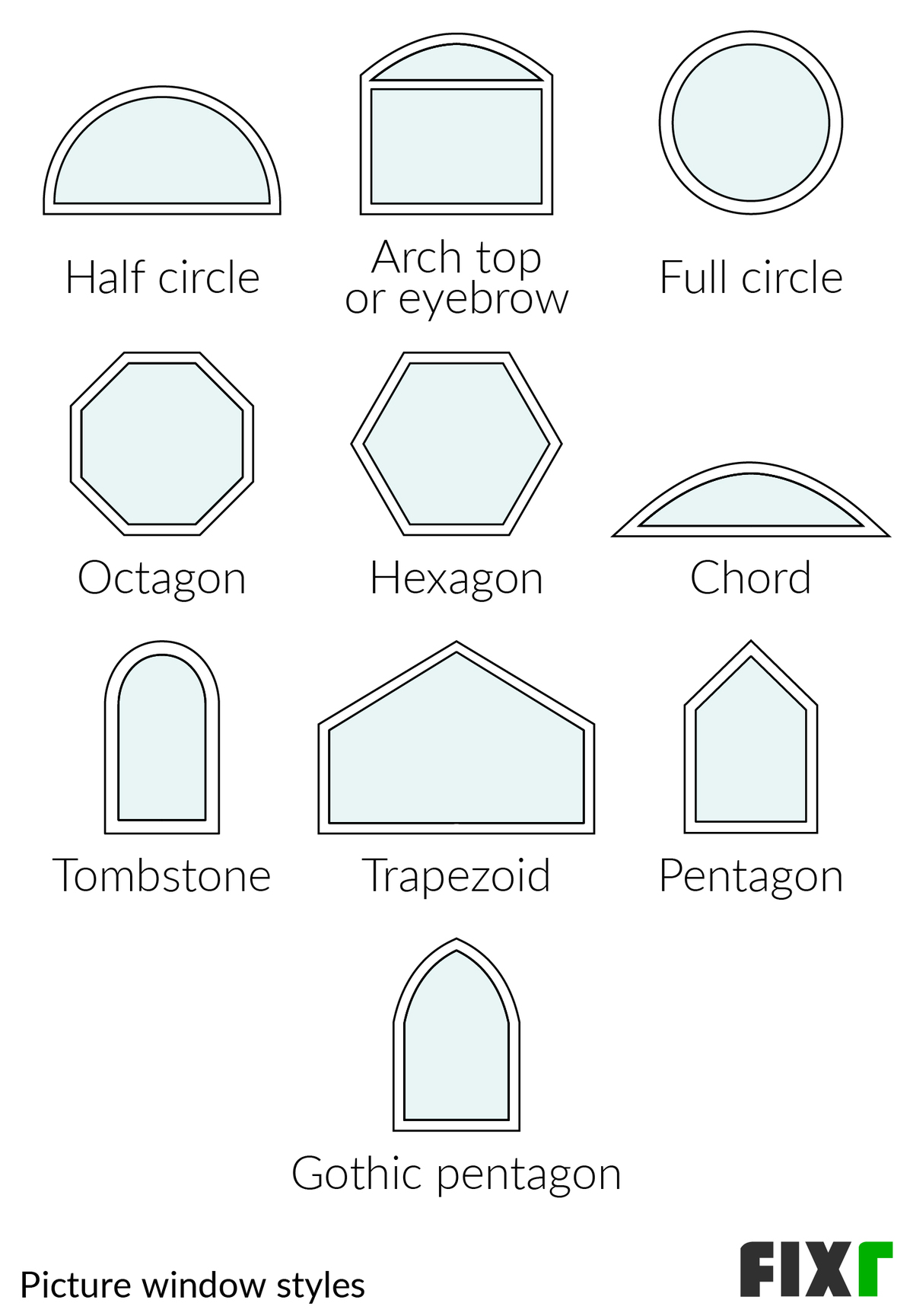
Half Circle
Half circle picture windows are most commonly seen in entryways with higher ceilings. These windows are usually placed high up on the wall and are designed to let in additional sunlight to brighten up these areas. In some cases, they provide a unique view from the stairwell.
Arch Top or Eyebrow
An arch top picture window, sometimes referred to as an eyebrow picture window, is similar in shape to a half circle window but is used in conjunction with another window. This window type is most often placed over the top of a glass door in rooms where more natural light is needed.
Full Circle
Full circle picture windows are typically used when you want to get some natural light into a room but don’t need a significant amount. They are used in areas with cathedral ceilings, such as entryways and living areas, and are placed high up on the walls. They can be found in finished attics when the room has been converted to a living space.
Octagon
Octagon picture windows are used for their unique geometric shapes. This shape is also often used high up on areas with cathedral ceilings though they can also be found in hallway areas. The octagon shape fits in well with more modern decor and is used to emphasize the theme.
Hexagon
Hexagon picture windows are very similar in design to octagon, though they are distinctive by having six sides instead of eight. They can be used in modern design styles and are also popular in rooms with nautical themes as they can be reminiscent of the windows typically found on ships.
Chord
Chord picture windows are almost no different than a half circle window except that their height tends to be lower. They are commonly placed above other windows, whether another picture window or other style to enhance the look. They can be used in any room in the house where you would like to get a little more light in than the other window is providing.
Tombstone
Tombstone windows are distinctive in their appearance by their rectangular base and rounded top, similar to that of a tombstone. These windows tend to be larger and are used in rooms where you want a significant amount of natural light. They fit in more with classic decor and are chosen for their simple shape and the ease of finding window treatments.
Trapezoid
A trapezoid picture window is a unique design, though not one commonly used. Homeowners choose them when they are looking for more unique geometric patterns in their decor. They can be used on their own as a window high on a wall but are more often used above a normal rectangular window, with their long side butted up against the top.
Pentagon
A pentagon-shaped picture window is another one less commonly seen. It would be used in the same instances as you would an octagon or a hexagon-shaped one. They provide a unique look to entryways or cathedral ceilings or work to let light into darkened hallways where wall space may be minimal.
Gothic Pentagon
The shape of a gothic pentagon picture window is the same as a pentagon picture window. The primary difference between the two is that the gothic pentagon window has a more ornate frame decorated in the gothic-era style. If you have gothic decor in your home or a more ornate theme, this option may suit you best.
Custom Picture Windows
Custom picture windows cost more than your standard size options, running between $900 and $2,500. The reason for the significant increase in cost is due to a few factors. The glass has to be cut to the desired specifications, and you must purchase a custom-made frame to fit the dimensions. On top of the extra material costs, labor for installation costs you more as it might require more onsite preparation due to the unusual size or shape of the piece.
Energy-Efficient Picture Windows
If you are looking for more energy-efficient window options, you can expect to pay on the higher end between $700 and $1,500. You can maximize efficiency by opting for a triple-pane window or opt for material specifically designed to be more energy-efficient. Argon gas-filled windows create an extra layer of insulation between the panes, while Low-E glass options improve efficiency by reducing the amount of heat and UV rays that come through the window. You can increase the energy efficiency of your picture window by choosing frames that seal better, such as wood and fiberglass.
Maintenance
Picture windows do not need more maintenance than other windows and, in many cases, require less. Because there are no moving parts, only the glass and the exterior of the frame need to be cleaned. There are no sliding tracks to clean and maintain and no locks or gears to repair.
In most cases, the maintenance is simply keeping the glass and frame clean and ensuring that the caulk around the frame remains intact. You may need to scrape and repaint the exterior frame, particularly if this is a wood frame, every few years to keep it looking its best.
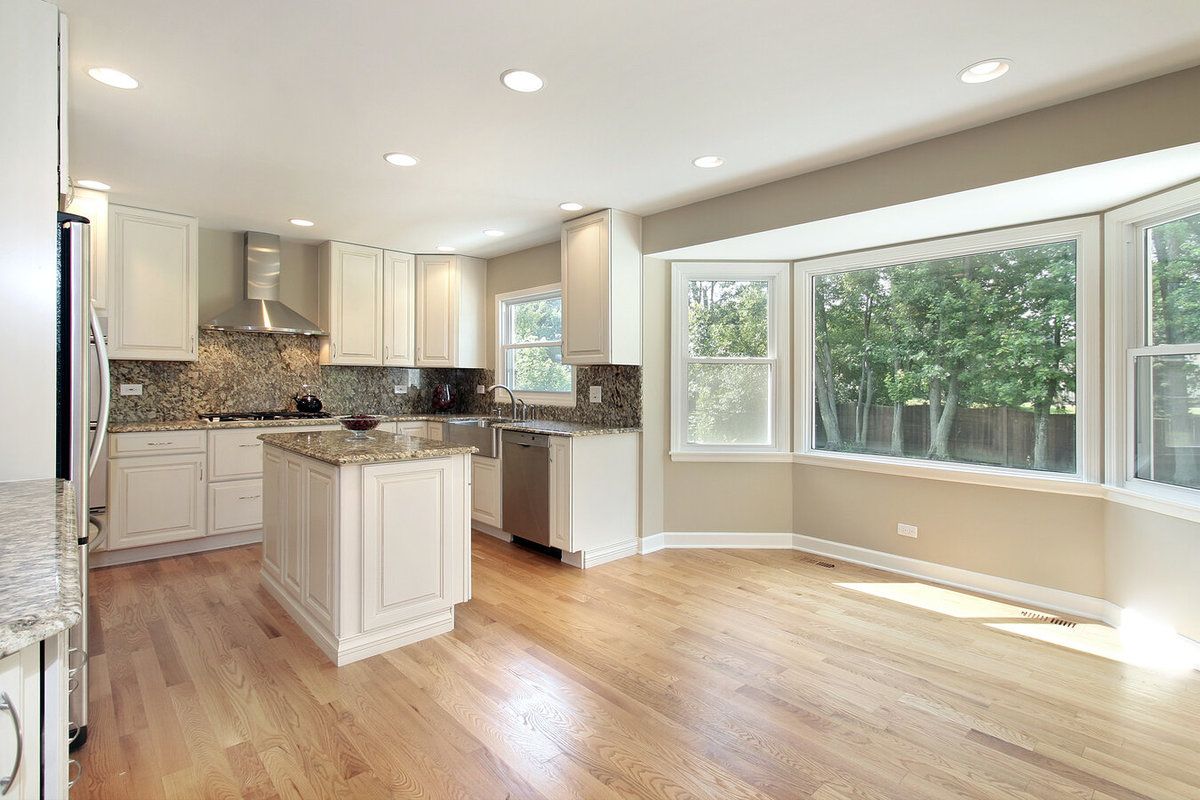
Pros and Cons
Picture windows are unique because they are designed solely for the view and not for ventilation. They do not open, so they do not allow air to circulate throughout the home. They are usually large, made of a single sheet of glass. They may be installed alone or with smaller windows on either side. Using one of these windows maximizes the amount of light in a room while providing a better view of the outside. You would especially appreciate that if you have a view or beautiful landscape outside.
Picture windows are simply a large sheet of glass in a frame. So, unless you are using thickened and energy-efficient glass, this large window can have drawbacks. It may allow UV light and heat to enter the home if the sun is directed at it and may not insulate as well as a solid wall unless you are using insulated glass. Large picture windows that do not use oversized frames or thickened glass may crack or break easily, becoming a security hazard. If you choose to use insulated, thickened glass and an oversized frame, the cost of the window can increase drastically.
Bay Window vs Picture Window
Bay windows cost between $1,200 and $3,600 to have installed. Like picture windows, they are often utilized for aesthetic purposes. Bay windows are often multiple windows, usually three, set in an angled frame that protrudes from an exterior wall, creating a bay. The construction and size of these windows contribute to a higher cost.
They give a better view than traditional windows, though the view is not obstructed like you get with a picture window. But, unlike the latter, you can open the windows to let in the fresh air. Bay windows let in less light than the other type. You may need to take that into consideration if light is the optimal goal.
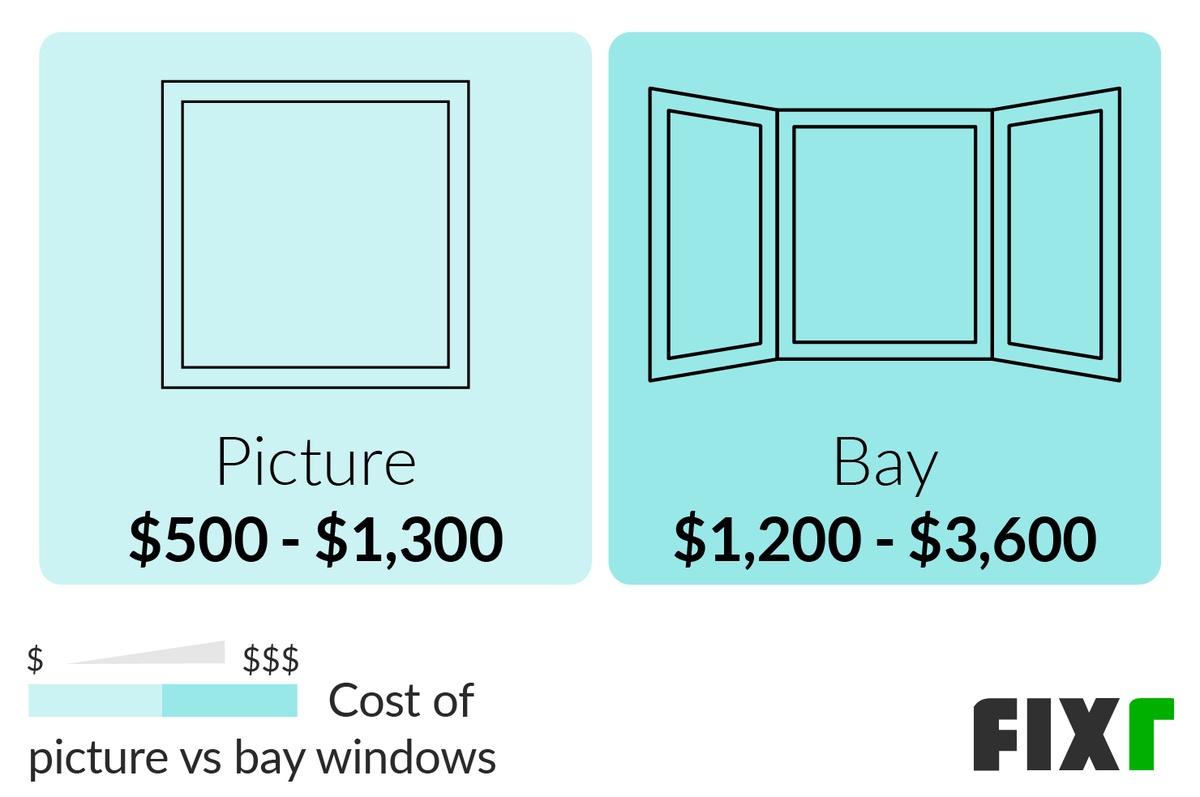
| Window Type | Average Cost (Installed) |
|---|---|
| Picture | $500 - $1,300 |
| Bay | $1,200 - $3,600 |
Casement vs Picture Window
Casement windows cost between $200 and $2,000, depending on which type of frame you choose. Casement windows are designed to open by either swinging upward or out to the side. In some cases, you may even need to use a hand-crank to open one. Most casement windows have one of the panes on the left and one on the right. When it comes to cost, as it happens with other types of windows, casement windows with vinyl frames cost the least, while those with wood frames are more expensive.
The average cost for a picture window is $500 to $1,300. They are made of one large piece of glass, which prevents them from opening in the way casement windows do. But unlike casement windows, they are designed to provide an unobstructed view and let in significantly more natural light than other window types.
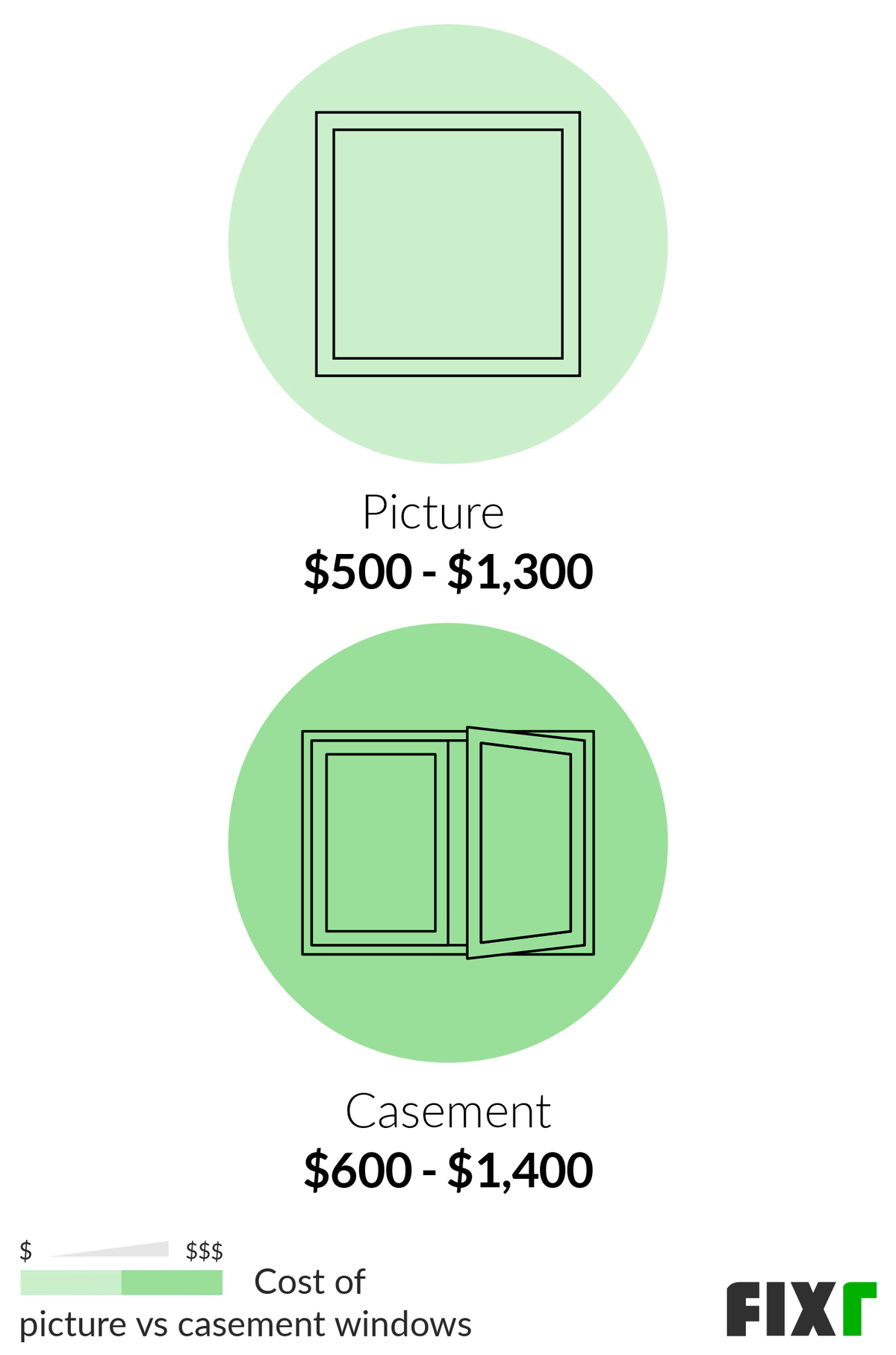
| Window Type | Average Cost (Installed) |
|---|---|
| Picture | $500 - $1,300 |
| Casement | $600 - $1,400 |
Enhancement and Improvement Costs
Picture Window With Two Side Windows
You can expect to pay between $500 and $3,000 when installing a picture window with two side windows. This window type is popular when a homeowner wants to maximize the view, but the wall is extremely large. Homeowners may choose this option when they want the look of a picture window and want to have windows that open in the room to provide fresh air circulation.
Mullions
Mullions are supporting bars used to separate the two sides of a single window. Mullions can be added to a window for $25 to $75. Mullions are most often vertical and made from the same material as the frame. Since buying a large piece of glass is pretty expensive, these were more often used in older homes, using multiple panes joined with a mullion to create a larger piece look. Mullions are affixed to the wall to provide the support needed to keep multiple panes in place.
Old Window Removal
Many companies roll the cost of removing the old window into the total cost of the project, but some do not. It costs between $50 to $200 additional, depending on the size of the window, to remove an old picture window and dispose of it.
Window Inspection
If you are unsure of the type and size of your window and whether it needs to be replaced, have a window inspection done. Have a professional examine the frame, glass, and installation to give you a better idea of how efficient it is and its condition. This costs $100 in most cases but may be rolled into the cost of the new window if you purchase and install it using the same company.
Additional Considerations and Costs
- Multiple window installation. Replacing three or more windows at one time can lower the installation cost.
- Room types. Picture windows can be installed in different rooms. They are most likely to be installed in rooms with high ceilings and in areas that provide a nice view.
- Combining windows. You can combine picture windows with other window types, such as casement windows, that provide ventilation. It is common to flank a picture window with other windows on either side.
- Climate. The type of window material and glass you choose may be influenced by the area where you live. For example, very sunny climates may need a reflective coating on the glass.
- Permits. You may need a permit for this job. Check with your local town or city hall before proceeding.
- Warranty. Most new windows come with a warranty. The installation is usually guaranteed for one year, while the window itself may have a ten-year warranty. Always ask about the available warranties.
FAQs
- Can you open a picture window?
No, picture windows are not meant to be opened. However, they are often flanked by windows that can be opened.
- What is the standard size of a picture window?
There is no standard size. Standard widths include 2, 3, 4, 6, and 8 feet, while standard heights range from 1 to 8 feet.
- How much does a double pane picture window cost?
A double-pane picture window can cost between $450 and $800 to install, depending on the type of frame and size of the window.
- How wide can a picture window be?
Picture windows come in a wide range of widths, but typically the maximum length that you can have is 9’4”. After this width, the window would be too difficult to install and find a sound piece of glass.
How much does it cost to install picture windows in my city?
Cost to install picture windows varies greatly by region (and even by zip code). To get free estimates from local contractors, please indicate yours.

